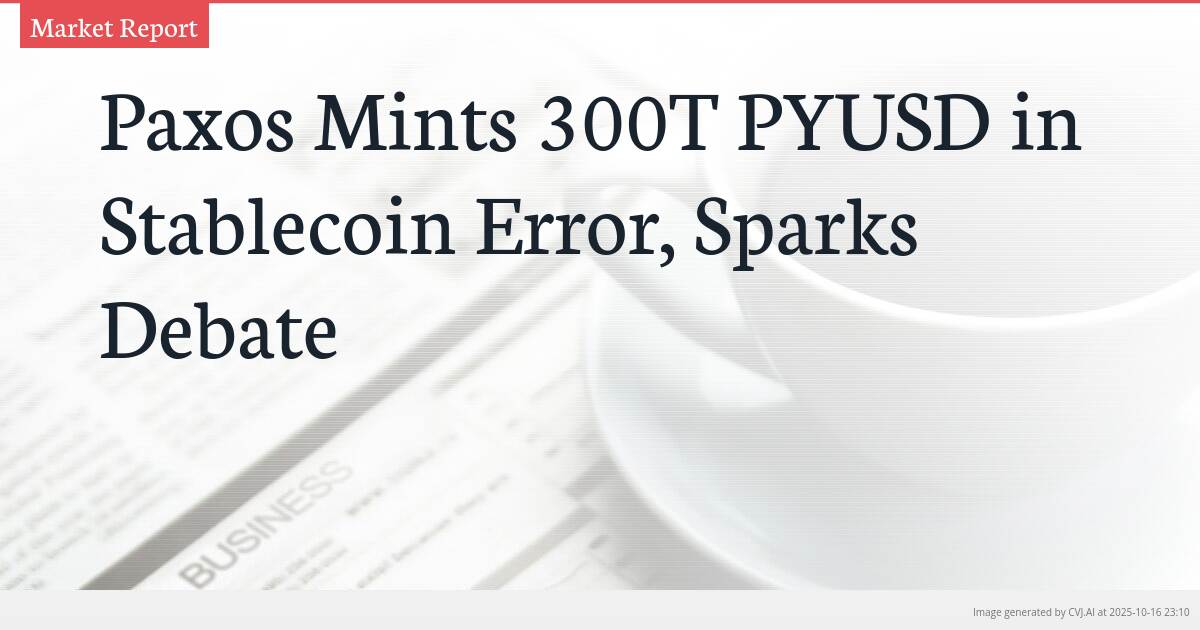This summary text is fully AI-generated and may therefore contain errors or be incomplete.
Introduction
In a stunning technical mishap that sent shockwaves through the cryptocurrency world, Paxos, the issuer behind PayPal’s PYUSD stablecoin, accidentally created 300 trillion PYUSD tokens—briefly inflating the digital dollar supply to levels exceeding the entire global money supply. The company swiftly corrected the error by burning the excess tokens, but the incident has reignited critical debates about stablecoin oversight, risk management protocols, and the fragile balance between innovation and accountability in digital finance.
Key Points
- The 300 trillion PYUSD minting error would have exceeded the entire US M2 money supply by 14 times and nearly tripled global M2 supply
- Paxos identified and corrected the error within minutes, burning the excess tokens and confirming no security breach or customer fund impact
- Stablecoin market dominance has risen to 8.49%, reflecting increased risk aversion and liquidity reserves following recent market corrections
The Trillion-Dollar Typo: Anatomy of a Minting Catastrophe
The error occurred during what should have been a routine internal transfer at 3:12 PM EST, when Paxos mistakenly added six extra zeros to the intended transaction amount. Instead of minting 300 million PYUSD as planned, the system generated 300 trillion PYUSD—a figure so astronomical it would have exceeded the entire United States money supply (M2), currently around $21 trillion, by nearly 14 times. To put this in global perspective, the mistakenly minted amount represented almost three times the total estimated global M2 money supply of roughly $100 trillion, creating enough digital dollars in that brief moment to theoretically purchase nearly every publicly traded company worldwide.
The crypto community immediately noticed the jaw-dropping figure, with traders and analysts expressing disbelief across social media platforms. The incident quickly became the subject of widespread humor and criticism, with many mocking what could have been the largest minting error in cryptocurrency history. While Paxos acted within minutes to identify and correct the mistake, burning the excess tokens and reissuing the correct 300 million PYUSD amount, the event exposed the vulnerability of even the most regulated stablecoin issuers to simple human or technical errors.
Transparency vs. Regulation: The Aftermath and Industry Response
Paxos moved quickly to address concerns, confirming on social media platform X that the incident was purely an internal technical error with no security breach and that customer funds remained safe throughout the process. The company stated it had ‘addressed the root cause,’ but the damage to industry confidence was already done. The event sparked immediate debate about stablecoin minting procedures, with some industry observers arguing that such incidents underscore why stablecoin issuance—particularly when tied to major financial institutions like PayPal—should face stricter regulatory standards and oversight mechanisms.
Others in the crypto community countered that blockchain’s inherent transparency functioned exactly as intended—the mistake was instantly visible on-chain, verifiable by anyone, and corrected without any actual financial harm. This perspective highlights the ongoing tension within the stablecoin sector between innovation and automation on one hand, and the level of oversight and accountability expected from entities that effectively issue digital representations of real-world money on the other. The incident serves as a stark reminder that while blockchain technology provides unprecedented transparency, it cannot eliminate the risk of human error in operational processes.
Broader Market Context: Rising Stablecoin Dominance Signals Caution
The Paxos incident occurred against a backdrop of increasing risk aversion in cryptocurrency markets, as evidenced by rising stablecoin dominance. Data shows stablecoin market dominance has climbed to 8.49%, reflecting a notable shift toward safety following recent market corrections. This metric, which had dipped below 7.5% in late September, rebounded sharply during last week’s market crash, even briefly spiking near 9.5%—the highest level since early June.
The surge in stablecoin dominance aligns with massive minting activity reported by major issuers Tether (USDT) and Circle (USDC), which together issued over $4.5 billion in new stablecoins after the recent sell-off. This movement suggests that large players and institutions are preparing liquidity reserves for potential market re-entry or enhanced risk management amid ongoing uncertainty. The preference for stablecoins like USDT, USDC, and DAI over volatile assets such as Bitcoin (BTC) and altcoins indicates a cautious but liquid market environment where participants remain ready to act once volatility stabilizes.
If stablecoin dominance continues to consolidate around 8-9%, it may signal that investors remain hesitant to redeploy capital into crypto assets, potentially waiting for confirmation of a market bottom. Conversely, a sustained decline below 8% could mark renewed confidence and capital inflows into Bitcoin and alternative cryptocurrencies. For now, the market appears to be in a holding pattern, balancing between the safety of stablecoins and the potential returns of more volatile digital assets.
📎 Read the original article on newsbtc.com

